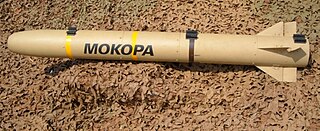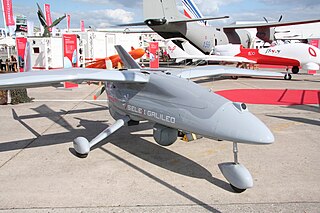
The Denel Rooivalk is an attack helicopter manufactured by Denel Aviation of South Africa. Rooivalk is Afrikaans for "Red Falcon", which refers to the lesser kestrel. Development of the type began in 1984 by the Atlas Aircraft Corporation, its development is closely connected to the Atlas Oryx transport helicopter, both aircraft being based on the Aérospatiale SA 330 Puma and having started development at the same time.

The Valour class is a class of frigates built for the South African Navy. Part of the MEKO family of warships, the German shipbuilder Blohm+Voss officially designate the class as the MEKO A-200SAN.

The Atlas Cheetah is a South African fighter aircraft designed and produced by the aviation company Atlas Aircraft Corporation. It was primarily designed and developed to be operated by the South African Air Force (SAAF).

The Bateleur is an unmanned aerial vehicle (UAV) prototype designed and built by Denel Dynamics. It has been designed as a MALE UAV, with its primary role being surveillance, with a secondary signals intelligence capability.

The South African National Defence Force (SANDF) comprises the armed forces of South Africa. The commander of the SANDF is appointed by the President of South Africa from one of the armed services. They are in turn accountable to the Minister of Defence and Military Veterans of the Defence Department.

The ZT-6 Mokopa is a South African air-to-ground anti-tank guided missile. As of 2005, it is in its final stages of development, and is being integrated onto the South African Air Force's Rooivalk attack helicopters. The missile is produced by Denel Dynamics, formerly Kentron. The current version uses semi-active laser (SAL) guidance, requiring the target to be illuminated by a laser designator either on the launch platform or elsewhere; though there are alternative guidance packages available including a millimetre-wave radar (MMW) seeker and a two-colour imaging infrared (IIR) seeker.

The Umkhonto is a family of vertical-launched, surface-to-air missiles developed by Denel Dynamics. Umkhonto is designed to be a modern, short to medium-range missile, with an all-weather launch capability. Operating at supersonic speeds, the Umkhonto utilises infrared homing technology to provide point and limited local air defence against multiple attacks of aircraft and missiles.
The usefulness of UAVs for aerial reconnaissance was demonstrated to the United States in the Vietnam War. At the same time, early steps were being taken to use them in active combat at sea and on land, but unmanned combat aerial vehicles would not come into their own until the 1980s.

The General Atomics MQ-9 Reaper is an unmanned aerial vehicle capable of remotely controlled or autonomous flight operations, developed by General Atomics Aeronautical Systems (GA-ASI) primarily for the United States Air Force (USAF). The MQ-9 and other UAVs are referred to as Remotely Piloted Vehicles/Aircraft (RPV/RPA) by the USAF to indicate ground control by humans.

The ZT3 Ingwe (Leopard) is a modern South African multi-role laser beam riding anti-tank guided missile (ATGM) manufactured by Denel Dynamics.
Denel Aeronautics is the aviation and aerospace division of the state-owned Denel corporation of South Africa. It is one of the successors of the South African aviation company Atlas Aircraft Corporation.
The V3E A-Darter is a modern short-range infrared homing air-to-air missile, featuring countermeasures resistance with a 180-degree look angle and 120-degrees per second track rate, developed by South Africa's Denel Dynamics and Brazil's Mectron, Avibras and Opto Eletrônica. It will equip the South African Air Force's Saab JAS 39 Gripen C/D and BAE Hawk 120, and the Brazilian Air Force's A-1M AMX, Northrop F-5BR and Gripen E/F. It was expected to be in production before the end of 2015. As of November 2022, no combat capable missiles had been produced.
The R-Darter is a beyond visual range (BVR) air-to-air missile guided by an active radar homing seeker. It was designed and manufactured by the South African firm Kentron, now known as Denel Dynamics.

The TAI Anka is a family of unmanned aerial vehicles developed by Turkish Aerospace Industries primarily for the Turkish Air Force. Envisioned in the early 2000s for aerial surveillance and reconnaissance missions, Anka has evolved into a modular platform with synthetic-aperture radar, precise weapons and satellite communication.

The Falco is a tactical unmanned aerial vehicle (UAV) designed and produced by Selex ES. The UAV is designed to be a medium-altitude, medium-endurance surveillance platform capable of carrying a range of payloads, including several types of high-resolution sensors. A larger variant, the Falco EVO, is capable of carrying larger payloads is also available. Neither system is designed to carry weapons, The launch customer, Pakistan, reportedly wanted the Falco armed, a request that Italy rejected.

The Umbani is a precision-guided bomb kit manufactured by Denel Dynamics in South Africa. It consists of a number of modules fitted to NATO standard Mk81, Mk82 or Mk83 low drag free-fall bombs to convert them into guided glide bombs.

The Denel Dynamics Skua is a turbojet-engined target drone used to simulate fast-moving attack aircraft during surface-to-air and air-to-air training exercises and weapons tests. It is manufactured by the Denel Dynamics division of the South African state-owned Denel aerospace and defence conglomerate.

The Raytheon Coyote is a small, expendable, unmanned aircraft system built by the Raytheon Company, with the capability of operating in autonomous swarms. It is launched from a sonobuoy canister with the wings deploying in early flight phase.

The Shahpar-ll is an unmanned combat aerial vehicle (UCAV) built by Global Industrial Defence Solutions of Pakistan. It is currently in production following the completion of a test and qualification phase.















